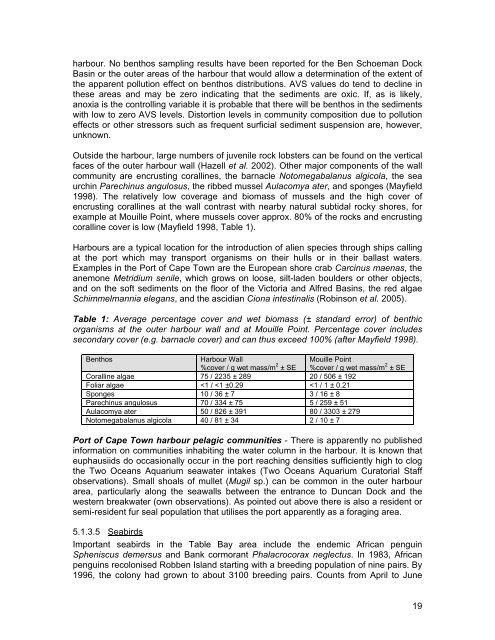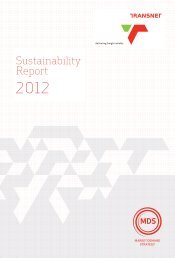BEN SCHOEMAN DOCK BERTH DEEPENING Specialist ... - Transnet
BEN SCHOEMAN DOCK BERTH DEEPENING Specialist ... - Transnet
BEN SCHOEMAN DOCK BERTH DEEPENING Specialist ... - Transnet
You also want an ePaper? Increase the reach of your titles
YUMPU automatically turns print PDFs into web optimized ePapers that Google loves.
harbour. No benthos sampling results have been reported for the Ben Schoeman Dock<br />
Basin or the outer areas of the harbour that would allow a determination of the extent of<br />
the apparent pollution effect on benthos distributions. AVS values do tend to decline in<br />
these areas and may be zero indicating that the sediments are oxic. If, as is likely,<br />
anoxia is the controlling variable it is probable that there will be benthos in the sediments<br />
with low to zero AVS levels. Distortion levels in community composition due to pollution<br />
effects or other stressors such as frequent surficial sediment suspension are, however,<br />
unknown.<br />
Outside the harbour, large numbers of juvenile rock lobsters can be found on the vertical<br />
faces of the outer harbour wall (Hazell et al. 2002). Other major components of the wall<br />
community are encrusting corallines, the barnacle Notomegabalanus algicola, the sea<br />
urchin Parechinus angulosus, the ribbed mussel Aulacomya ater, and sponges (Mayfield<br />
1998). The relatively low coverage and biomass of mussels and the high cover of<br />
encrusting corallines at the wall contrast with nearby natural subtidal rocky shores, for<br />
example at Mouille Point, where mussels cover approx. 80% of the rocks and encrusting<br />
coralline cover is low (Mayfield 1998, Table 1).<br />
Harbours are a typical location for the introduction of alien species through ships calling<br />
at the port which may transport organisms on their hulls or in their ballast waters.<br />
Examples in the Port of Cape Town are the European shore crab Carcinus maenas, the<br />
anemone Metridium senile, which grows on loose, silt-laden boulders or other objects,<br />
and on the soft sediments on the floor of the Victoria and Alfred Basins, the red algae<br />
Schimmelmannia elegans, and the ascidian Ciona intestinalis (Robinson et al. 2005).<br />
Table 1: Average percentage cover and wet biomass (± standard error) of benthic<br />
organisms at the outer harbour wall and at Mouille Point. Percentage cover includes<br />
secondary cover (e.g. barnacle cover) and can thus exceed 100% (after Mayfield 1998).<br />
Benthos<br />
Harbour Wall<br />
%cover / g wet mass/m 2 ± SE<br />
Mouille Point<br />
%cover / g wet mass/m 2 ± SE<br />
Coralline algae 75 / 2235 ± 289 20 / 506 ± 192<br />
Foliar algae

















